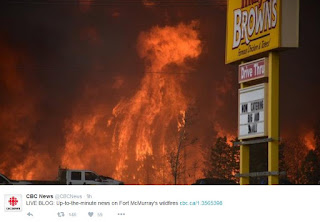 |
| Credit - CBC News Twitter |
# 11,339
Since it is being well covered in the media, I haven't posted about the horrific wildfire around - and evacuation of well over 50,000 residents from - Fort McMurray, Alberta. According to NBC News, however, this is the largest wildfire evacuation in Alberta's history (see Fort McMurray Wildfire: 60,000 Evacuated Over Out-of-Control Blaze).
While firefighters are working to contain this blaze, homes and businesses have already been destroyed, and authorities fear the worst is far from over.
Although the Alberta fire falls on the extreme end of the scale, every year we see thousands of instances where individual families, neighborhoods, long stretches of coastlines, and on rare occasions - even entire cities - are forced to leave their homes for their own safety.
The causes may be as large as an out-of-control wildfire, a hurricane or tsunami - or something more localized like an industrial accident, rising flood waters, or even a house or apartment fire.
While you and your family might get a day or two to prepare with an approaching hurricane, with many of these other threats, you may have only hours or minutes to gather your things and get out of Dodge.
And it could easily happen to you.
Being able to leave in a hurry when an evacuation has been ordered means having a plan, a destination, and an emergency `to go’ kit or `BOB’ already equipped, and standing by.
 |
| My Bug Out Bag - Toiletry Kit - Canteen |
In the vernacular, a `bug-out bag' or `BOB’ (or sometimes GOOD bag for `Get Out Of Dodge’) a bag of emergency supplies, ideally kept at the ready, that one can grab on the way out the door during an emergency.Every hurricane season I go through my personal bug out bag, and replace flashlight and radio batteries from last year, and swap out older emergency rations for newer ones.
A BOB isn't supposed to be a survival kit, but rather, is supposed to provide the essentials one might need during the first 72 hours of a forced, and sometimes unexpected, evacuation.
It should contain food, water, any essential prescription medicines, copies of important papers (ID's, insurance, important Phone #s), a first aid kit, portable radio, flashlight, extra batteries, and ideally blankets and extra clothes.
Luckily, I have several pre-arranged places I can go. Friends, who are also disaster buddies (see In An Emergency, Who Has Your Back?), who know my couch is always available to them.
Ready.gov has the following advice on how to prepare for an evacuation
Evacuating Yourself and Your FamilySince I live in a hurricane evacuation zone, I have an emergency plan, a pre-arranged place to go, and my evac kit (see Inside My New Bug Out Bag) packed and ready to go.

There may be conditions under which you will decide to get away or there may be situations when you are ordered to leave. Follow these guidelines for evacuation:
- Plan places where your family will meet, both within and outside of your immediate neighborhood. Use the Family Emergency Plan to decide these locations before a disaster.
- If you have a car, keep a full tank of gas in it if an evacuation seems likely. Keep a half tank of gas in it at all times in case of an unexpected need to evacuate. Gas stations may be closed during emergencies and unable to pump gas during power outages. Plan to take one car per family to reduce congestion and delay.
- Become familiar with alternate routes and other means of transportation out of your area. Choose several destinations in different directions so you have options in an emergency.
- Leave early enough to avoid being trapped by severe weather.
- Follow recommended evacuation routes. Do not take shortcuts; they may be blocked.
- Be alert for road hazards such as washed-out roads or bridges and downed power lines. Do not drive into flooded areas.
- If you do not have a car, plan how you will leave if you have to. Make arrangements with family, friends or your local government.
- Take your emergency supply kit unless you have reason to believe it has been contaminated.
- Listen to a battery-powered radio and follow local evacuation instructions.
- Take your pets with you, but understand that only service animals may be permitted in public shelters. Plan how you will care for your pets in an emergency.
Of course, you’d be hard pressed to put everything for a family of four into one bag. So each family member should have their own BOB. Some items, like the radio, lights, and first aid kit needn’t be duplicated in each bag.
I keep my BOB within arm’s reach of my first aid kit, and would hopefully be able to grab both, even in an emergency. On top of this, I keep a spare first aid kit in my car, along with an `overnight bag’, and I have a third duffel bag packed with extra supplies, that I would hopefully be able to throw in the car as well.
But if I had to, I could easily go 72 hours on just my bug-out bag alone.
I do these things to give me peace of mind and confidence that I’m ready to deal with just about any emergency that comes my way.
The truth is, preparing is easy.
It’s worrying that is hard.